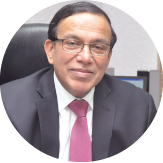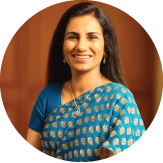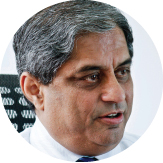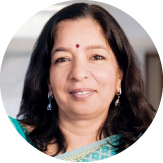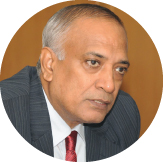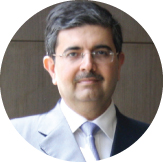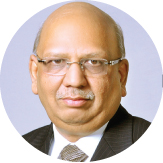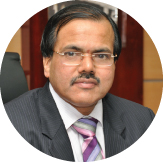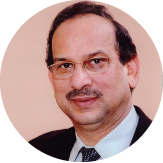Little is understood of India's banking sector outside of the vast country. The Banker talks to the chairmen and CEOs of 15 of India’s leading banks about their strategies, prospects and the huge opportunities presented by the country's large unbanked population.
State Bank of India
The biggest bank in India by every measure and four times larger in asset terms than its nearest rival, the 62% government-owned State Bank of India (SBI) is the giant of Indian banking and is targeting 20% year-on-year growth in its core business – credits and deposits – during the current 2012-13 financial year.
The pace of credit expansion moderated in 2011-12 to 16% from 20.3% the year before, while deposits also decelerated to 14% growth from 16% in 2010-11, but chairman Pratip Chaudhuri is bullish about the banking prospects as India’s strong savings rate of 32% and low banking penetration (only 40% of the population is banked, and the country has a low credit-to-gross domestic product [GDP] ratio of 60%) allows plenty of room to grow. According to The Banker’s Top 1000 World Banks for 2012, SBI, despite being by far the largest bank in India, is still much smaller than the large Chinese banks, and 60th in the world, lagging behind eight banks operating out of China.
While India has emerged from the global financial crisis relatively unscathed, and Mr Chaudhuri is keen to point to the country's huge growth potential, he intends to use his expanding 14,000-branch network and 16% to 17% market share to tap into the huge unbanked market in India, as well as the estimated $200bn in cash that exists outside of the banking system. With potential in areas such as consumer, infrastructure, agriculture, small and medium-sized enterprises (SMEs) financing and wealth management, Mr Chaudhuri sees SBI’s market share eventually rising to between 22% and 24%. He adds that as India has 800 million mobile telephone users and only 400 million bank accounts, there is great potential in mobile banking.
With regards to SBI's international role, Mr Chaudhuri says that the bank has 170 offices overseas in 34 countries and international operations account for 15.2% of its business. While advocating a new strategy to introduce strategic consultancy groups into key areas such as power and project finance, SBI is not about to go on an acquisition splurge in Europe, but will instead quietly strengthen its focus on non-resident Indians (NRIs) in the UK and Singapore, as well as maintain its return on equity in the 16% to 18% range.
ICICI Bank
A dominant force in banking in India since its inception in 1994, ICICI Bank, India’s largest private sector bank, has continued to expand both domestically and internationally, boasting a domestic network of 2752 branches and 9006 ATMs as of the end of March 2012, as well as a presence in 19 countries accounting for 25% of its profits. The bank showed a 26% increase in post-tax profits in the year to the end of March 2012 to reach $1.3bn, and is the second largest bank in India as well as the 110th in the world, according to The Banker’s Top 1000 World Banks for 2012.
CEO Chanda Kochhar says that the bank’s focus is on India, particularly Indian companies going global, with growth coming from domestic operations and global companies looking at India, including foreign banks. Ms Kochhar believes banking in India will grow at two-and-a-half times the country's GDP, which means at 17% to 18% and with an expanding economy and better credit penetration, she expects banking growth of 23% to 25% annually over the next decade. This, Ms Kochhar says, translates into a banking sector five times its current size in a decade's time.
While she accepts India is eight to 10 years behind China in terms of its economy, Ms Kochhar believes economic growth in India will propel its banking sector and she is bullish about opportunities in mortgages, and consumer, trade and infrastructure finance. She is confident that, like China, India will grow much more in its oncoming investment phase and ICICI will be at the centre of that growth, although her bank is only a quarter the size (in asset terms) of market leader SBI.
ICICI currently has subsidiaries in the UK, Russia and Canada, branches in the US, Singapore, Bahrain, Hong Kong, Sri Lanka, Qatar and Dubai International Finance Centre, and representative offices in the United Arab Emirates, China, South Africa, Bangladesh, Thailand, Malaysia and Indonesia. The UK subsidiary has branches in Belgium and Germany. The bank has strong capital adequacy of 18.52% and Tier 1 of 12.68% as of the end of March 2012.
HDFC Bank
A Mumbai-based, new-generation private sector bank that launched in 1994, HDFC Bank has grown rapidly to become India’s 3rd largest bank and the 170th largest in the world, according to The Banker’s Top 1000 World Banks for 2012. The pan-India bank, which has a network of 2544 branches and 9000 ATMs in 1399 Indian towns and cities, saw continued strong growth in the year to the end of March 2012, with net profits up 31.6%, balance sheet up 21.6% and its capital adequacy ratio reaching 16.5%, already meeting Basel III requirements.
Managing director Aditya Puri says HDFC’s business is shared equally between wholesale and retail and is a market leader across its product range with an overall 3.5% market share. He expects this figure to grow to 10% in the next five to 10 years, with big opportunities arising in semi-urban and rural areas. Mr Puri says that the huge potential in these areas can be realised without having to take any undue risk.
Of the poverty that blights much of India, Mr Puri says: “The way out of poverty is not charity.” He adds that HDFC believes that financial inclusion means to provide holistic needs-based financial services to the people in the bottom of the pyramid, not just loans. This, he says, is a powerful tool to fight poverty. He also says that the bottom-of-the-pyramid segment in the rural and urban areas has tremendous potential and scope for offering huge business HDFC, and can help it to maintain its growth trajectory on a sustainable basis. HDFC is also involved in microfinance, and Mr Puri says his goal is to take 10 million Indians from below the poverty line to above it by providing viable financing.
While listed on the New York Stock Exchange, HDFC retains a largely domestic focus, which is where it sees its best opportunities and where it is a leader not only in retail but also in corporate lending, settlement activities, project finance and gold.
Bank of Baroda
Mumbai-based Bank of Baroda (BoB), founded in 1908, is seen as the international bank of India, with 90 branches across 26 countries, and is also viewed as the country’s third largest bank in business terms (loans and deposits) behind SBI and PNB, with a domestic network of 4000 branches, according to chairman M D Mallya. The Banker’s Top 1000 World Banks for 2012 places Bank of Baroda as the fourth largest bank in India and 173rd largest in the world.
Mr Mallya says BoB opened 525 branches in 2011, and achieved credit growth of 26% to 27% along with a return on equity of 21% and a cost-to-income ratio of a very acceptable 38%. He believes opportunities for his bank in India are abundant and expects to grow its market share from the current 4.5%, building on BoB's shared vision of “trust, togetherness and transparency”. His aim is to achieve a compound annual growth rate of 27%, which BoB managed in 2011-12, and Mr Mallya expects to double the bank's business every three years.
After opening operations in Mombasa, Kenya, in 1953, BoB has established a significant international presence in 26 countries, including the major financial centres of New York, London, Brussels, Dubai, Hong Kong and Singapore, as well as a joint venture in Zambia and representative offices in Thailand and Australia. BoB is pursuing an ambitious overseas expansion plan to better serve its 43 million global customers, and is looking to boost its branch network in UAE, Oman, Mauritius, New Zealand, Uganda, Botswana, Tanzania, Ghana and Guyana. Mr Mallya says that 27% of BoB's overall business and 25% of profits come from international business.
Mr Mallya sees BoB as a financial conglomerate offering all types of products, including insurance and mutual funds. The Indian government owns 57% of the bank, which focuses on all segments and has adopted a system of centralised hubs for credit monitoring, origination and credit matching, and has also, with the help of global management consulting firm McKinsey, successfully implemented a business process re-engineering system.
Punjab National Bank
Founded in Lahore in 1895, Delhi-based Punjab National Bank (PNB) is India's largest public sector bank after State Bank of India, and has the largest branch network of the nationalised banks (SBI is not nationalised), with 5500 branches and 5700 ATMs. General manager Sushma Bali says that PNB’s business grew by 23% in the year to the end of March 2012, and its share of the deposit market rose to 5.5%. According to The Banker’s Top 1000 World Banks for 2012, PNB is the fifth largest bank in India and the 175th largest in the world.
Ms Bali says that PNB, which is 58% owned by the Indian government, has maintained a very strong net interest margin of 3.55% in the 2011-12 fiscal year, and also a healthy capital adequacy at the end of 2011 of 12.79%, with a core Tier 1 of 9.15%. Its net profit was up 7% for the first nine months of 2011, providing a credible 1.16% return on assets.
The bank added 6500 employees in 2011 to reach a total of 62000, and, like other banks in India, is focusing on rural and semi-urban areas, where it has 62% of its branches. PNB has 95 retail hubs along with 700 clusters focusing on SMEs and 250 exceptionally large branches focused on large loans to corporates and infrastructure finance. Given the bank’s 60 million customer base and its strong credibility within India, Ms Bali is optimistic about its future growth, especially considering its strong savings rate among pensioners.
Overseas, PNB has a presence in 10 countries, including a UK subsidiary with seven branches, a subsidiary in Kazakhstan, joint ventures in Nepal and Bhutan, branches in Dubai and Hong Kong, representative offices in Norway, Shanghai, Dubai and Australia, and it has plans for a branch in the Norwegian capital of Oslo and subsidiaries in Australia and Canada aimed at the NRI market. The bank is also hoping to move into Pakistan and Bangladesh.
Axis Bank
Established in 1994 along with a number of other private banks, Mumbai-based Axis Bank grew dramatically between 2003 and 2009, changing its name to Axis in 2007, and aiming to be the preferred financial solutions provider excelling in customer delivery through offering insight, empowered employees and smart use of technology.
The bank, says CEO Shikha Sharma, had built a strong network of 1622 branches at the end of March 2012, along with 9924 ATMs in 1050 cities and towns. According to The Banker’s Top 1000 World Banks for 2012, Axis is the sixth largest bank in India and 196th largest in the world.
Seen as one of the best online banks in India with an 11.4 million customer base, in fiscal year 2011-12, Axis saw demand deposits grow by 18%, retail advances up by 35% and net profit up by 25%. The bank is seen by Bloomberg as the country’s leading debt arranger with healthy capital adequacy of 13.66% and core Tier 1 capital of 9.45% along with a strong return on equity in excess of 20%.
Ms Sharma says Axis is a very profitable bank with strong net interest margins above 3.6%, the country's largest ATM network besides State Bank of India, and a continuing focus on customer acquisition. It also differentiates itself on distribution, brand and service offerings and is among the leading banks in India for electronic payments. Ms Sharma believes India’s high savings rate, favourable demographics (59% of the population is below 30 years of age), robust growth and underpenetrated banking sector (domestic credit is only 60% of GDP) present excellent opportunities for banks.
Axis has seven international offices, with branches in Singapore, Hong Kong, Dubai (at the DIFC) and Colombo in Sri Lanka, and representative offices in Shanghai, Dubai and Abu Dhabi and an application pending in the UK. Its total assets under overseas operations were $6.4bn as of the end of March 2012, a growth of 20% for the year.
Canara Bank
Established in 1906, Bangalore-based Canara Bank has grown from its strong southern foundations into a pan-India bank, with a network of 3800 branches. It is the seventh largest bank in India and the 197th in the world, according to The Banker’s Top 1000 World Banks for 2012. Focused on people orientation and assisting the needy rather than the more conventional thrust on maximising profits and delivering returns to shareholders, chairman S Raman explains that SMEs are at the heart of Canara’s strategy as the bank has a very strong rural presence with more than 56% of branches in rural or semi-urban areas.
Having set up its first overseas branch in London in 1981, Canara has another UK branch in the Midlands city of Leicester and branches in Hong King and Shanghai, with 4% of its business coming from overseas. Mr Raman, however, has plenty of overseas ambitions with applications in for branches in New York, Johannesburg and Qatar, and he hopes to build his overseas franchise to 10% of Canara's total business in the next five years.
With 67.7% owned by the government, and having strong capital adequacy in excess of 15%, Mr Raman believes his nationalised bank has the best capacity of all such institutions in India to expand and raise further capital. He sees enormous potential in rural and semi-urban areas, with nearly 60% of India's rural population still existing out of the banking fold, and the country's rural economy undergoing a silent revolution and offering a huge market of 600 million people living in 600,000 villages.
Given India’s reduced but still strong economic growth forecast of 6.9% for 2012-13, Mr Raman believes that Canara's banking assets will grow at close to 20% annually in the next three years. Canara has opened 867 branches in the past three years and with rising affluence/disposable income in India, Mr Raman also sees immense opportunities for expanding wealth management services and insurance.
Central Bank of India
Set up in 1911, Central Bank of India (CBI) was the first bank owned by Indians and managed by Indians – a swadeshi bank. A banking pioneer, the first to take over another bank and the first to employ women, the Mumbai-based institution was nationalised in 1969 and has a prominent place among the public sector banks with the third largest banking network of 3967 branches and 27 extension counters across the country. The bank continued to expand its network by opening 248 branches in the first three quarters of the 2011-12 fiscal year, and according to The Banker’s Top 1000 World Banks for 2012, CBI is the 11th largest bank in India and 317th largest in the world.
Chairman M V Tanksale says that the bank’s strategy is to utilise its pan-India network to further the socio-economic objectives of the country's government with an emphasis on financial inclusion and transforming the customer banking experience into a fruitful and enjoyable one and leveraging technology for efficient and effective delivery of all banking services.
With a customer base of 35 million, the CBI, which is 78%-owned by the government, is hoping to expand globally. Mr Tanksale says the bank owns 20% of Zambia Bank, has approval for a representative office in Kenya, and is trying for a licence in the DIFC in Dubai. It also intends to establish a presence in Hong Kong and Shanghai.
The chairman is bullish about the growth opportunities in India in the retail and small and medium-sized enterprise (SME) areas, especially given the country’s demographics, with 50% of its population under 30 years of age. His bank sees huge potential in rural villages and semi-urban areas, and is focusing on these places. Mr Tanksale says his customer base, as a result, will rise from 35 million at present to 50 million by 2017.
Kotak Mahindra Bank
Started as a finance company in 1985, Kotak Mahindra became a bank in 2003 and its founder and chairman Uday Kotak explains: “We are a 26-year-old company and a nine-year-old bank, and by market capitalisation of $8bn, the fifth largest bank in India.” A one-stop shop for all banking needs, Mumbai-based Kotak Mahindra Bank has grown to become, according to The Banker’s Top 1000 World Banks for 2012, the 12th largest bank in India and the 321st largest in the world.
With a network of 355 branches, the bank has made huge strides in specialised areas such as transaction banking, operating lending verticals, managing initial public offerings and providing working capital loans. Kotak has one of the largest and most respected wealth management teams in India, providing the widest range of solutions to high-net-worth individuals, entrepreneurs, business families and employed professionals.
Mr Kotak says that the bank is the leading Indian bank in terms of wealth management, with $17bn in funds under management made up of $12bn in assets under management and $5bn in its wealth management sector. He sees Kotak's strongest growth opportunities in transaction banking, wealth management, insurance and asset management, as the bank has the diversity, network and specialised group of 22,000 employees to provide a broad range of personal and corporate financial solutions.
The bank has a broad international footprint, with subsidiaries in London and New York and branches in Dubai and Singapore. Mr Kotak sees the bank growing at between 25% to 30% in the coming years, well above the expected sector growth of 18%.
At the end of March 2012, Kotak Mahindra Bank posted after-tax profits of Rs18.3bn ($360m), an increase of 17% on the previous year, and improved its capital adequacy ratio to 17.9%, with a core Tier 1 of 16.5%. Consolidated advances rose 29% to Rs531.4bn.
Oriental Bank of Commerce
Delhi-based Oriental Bank of Commerce (OBC) is a 58% government-owned bank that has taken off in the past 10 years, becoming the leading institution in terms of productivity in India, and the country's 13th largest bank, as well as the 330th largest in the world, according to The Banker’s Top 1000 World Banks for 2012.
Chairman S L Bansal says that although India's economy is expected to grow at less than 7% in 2012, banking will continue to grow and there are huge opportunities in personal lending and retail banking, infrastructure finance and also expansion abroad. OBC expanded lending in the financial year ending in March 2012 by 17.1%, and while only 45% of people in India are banked at present, Mr Bansal expects that figure to rise to 67% in 10 years' time.
At present, OBC has a national network of 1772 branches and Mr Bansal is planning to add 200 to 220 branches a year over the next five years to bring the network total to 3000. He believes that personal loans will double to 30% of his loan book in five years, and sees huge opportunities in housing and car loans. He also sees advantages in going abroad into African and east Asia in markets, catering for the expanding NRIs market.
OBC has 70% of its business in the public sector and 30% in the expanding retail sector, where deposits per branch hit an enviable Rs88 crore ($16.6m). OBC’s core Tier 1 at the end of 2011 was 9.51% and Mr Bansal expects it to exceed 10% in the end-March 2012 results. In provisional figures for March 2012, aggregate deposits rose 15.3% over the previous year, with return on equity reaching 11.75% at the end of December 2011.
Indian Overseas Bank
Formed in 1937, Chennai-based Indian Overseas Bank (IOB) has recently become one of India’s fastest growing banks, adding 627 branches in the past 18 months to bring its current network to 2639 branches, along with a sizeable international footprint. Its strong growth has seen it become the 14th largest bank in India and 344th largest in the world in The Banker’s Top 1000 World Banks for 2012, making it one of India’s expanding medium-sized banks.
Chairman M Narendra is proud of his bank’s overseas operations, which account for 10% of its business and 22% of profits. IOB is the only Indian bank with branches in Bangkok and Seoul, and also has branches in Hong Kong and Sri Lanka. Mr Narendra is also pleased that IOB is involved in a new joint-venture bank in Kuala Lumpur, called India International Bank (Malaysia), which is opening soon to service the large NRI population there. The new bank is owned jointly by Bank of Baroda (40%), IOB (35%) and Andhra Bank (25%).
IOB, owned 70% by the Indian government, has achieved high growth rates with advances and deposits growing by 27.9% and 21%, respectively, in the past year. Mr Narendra claims the bank has an overall market share of 2.7% in advances, and hopes to expand that to 3.5% in two to three years.
IOB’s focus is on SMEs and on expanding financial inclusion in India's village economies. Last year, IOB opened 250,000 new accounts in 1382 villages and Mr Narendra expects to continue to open more village accounts. Of the bank’s 2629-branch network, 1000 are in the Tamil Nadu state and the rest are across India. The bank improved its capital adequacy to 11.84% at the end of 2011 from 10.89% the previous year. Net profits in the nine months to the end of 2011 dipped to $116.8m due to higher provisions.
UCO Bank
Founded in 1943 and nationalised in 1969, Kolkata-based UCO Bank, now 65%-owned by the Indian government, has been under continuous expansion in recent years, with 280 new branches opened in the year to the end of March, bringing UCO’s network to 2400 branches and 880 ATMs. After taking over the bank in September 2010, chairman Arun Kaul has helped revitalise it, upgrading the skills of its employees and bringing in 200,000 new customers per month to build on its 18 million-strong customer base. According to The Banker’s Top 1000 World Banks for 2012, UCO Bank is the 20th largest bank in India and the 416th largest in the world.
Mr Kaul explains that he is restructuring the bank, creating 35 regional offices across India, developing new retail hubs where branches act only as sales outlets and implementing 84 city back offices to streamline operations and make better use of technology. He believes that with a better credit focus and the existing strong regulation, UCO can take advantage of the huge opportunities available within India. He has gone to great effort to improve the bank's NPL status, where gross NPLs currently stand at 3.6%. He has also taken action to reduce the average age of UCO's staff, which was about 58 years old. With a workforce numbering 24,000, and 2000 people retiring every year, Mr Kaul hopes to have 50% of employees below the age of 30 in five years' time, which he believes will improve growth and profits.
UCO has a modest international presence with operations in Hong Kong and Singapore accounting for 7.3% of total bank assets. In the year to the end of March 2012, net profits after tax rose by 11.2%, total assets rose 10.5% and capital adequacy was reported at 12.45%, with a core Tier 1 of 11.03%. The bank is on the mend, but Mr Kaul says there is still some way to go.
Yes Bank
Established in 2004 by its entrepreneur founder and CEO Dr Rana Kapoor, Mumbai-based Yes Bank represents a new and different banking model driven by a high-quality, service-driven culture that has had a strong focus on development banking. This is evident from the cutting-edge work that Yes Bank has done in the area of food and agribusiness, infrastructure, microfinance and sustainability which in most cases has been the first of its kind in India. Using a ‘partnership model’ and developing 12 to 14 knowledge centres in particular knowledge sectors, Yes has grown into the country’s fourth largest private bank and, according to The Banker’s Top 1000 World Banks for 2012, the 24th largest bank in India and the 561st largest in the world.
Mr Kapoor says that Yes has been recognised both domestically and internationally as one of the most innovative companies in the world, and adds that it has received the only greenfield licence awarded by the Reserve Bank of India in the past 16 years. Yes has now emerged as a full-service commercial bank providing innovative financial solutions by leveraging on its excellent product delivery through its 356 branches and 600 ATMs across the country.
Mr Kapoor believes there are many opportunities where Yes can play a pivotal role in transaction and investment banking, as well as in capital markets and advisory services. Although Yes has no global footprint, its international strategy is to service its correspondent banks’ businesses in India. As Mr Kapoor says: “We have no international bank but 600 global relationships.”
Based on its five key pillars of growth – trust, technology, human capital, transparency and responsible banking – Yes, whose foreign shareholders account for 49.2% of the bank, has continued to expand and at the end March of 2012, net profit after tax had risen by 34.4% for the year to Rs977 crore ($192m) and capital adequacy stood at a solid 17.5%, with a core Tier I at 9.9%.
IndusInd Bank
One of the new generation of Indian private sector banks, Mumbai-based IndusInd Bank, established in 1994, is a mid-sized bank which underwent a major management restructuring in 2008 leading to a significant financial turnaround over the past four years. The bank’s market capitalisation has risen dramatically, from $250m in 2008 to $3bn in 2012, and according to The Banker’s Top 1000 World Banks listing for 2012 it is the 25th largest bank in India and 595th largest in the world.
CEO Romesh Sobti, who took over at IndusInd in 2008, bringing with him four senior managers from ABN Amro’s India operations, has, with the help of the wealthy Hinduja Group (which holds a 19% stake in the bank), restored IndusInd to health and maintained the institution’s unique and leading position in vehicle financing. According to Mr Sobti, vehicles account for 50% of IndusInd’s loan book, and the structure of the bank is a network of 400 branches dedicated to general banking plus 700 separate branches across the country dedicated to vehicle finance.
Though IndusInd Bank is relatively small, Mr Sobti believes his financial inclusion model, with its strong use of technology, has brought impressive results, and he highlights how an innovation at his ATMs, called ‘Choice Money’, enabling customers to decide how notes are delivered, will attract an expected 900,000 new customers this year. Other innovations, such as the posting of scanned cheque images in statements, are also proving popular.
The bank’s results show strong growth, with a return on average equity of 19.23% in the 2011-12 fiscal year, along with a 39% rise in net profit. IndusInd has a modest overseas footprint with applications pending for branches in London and Hong Kong.
Mr Sobti is not concerned by the slight downturn in India's economic growth forecast for 2012 to 6.9%, and he is optimistic about the opportunities available within the country. In terms of size, however, he is adamant: “Appropriate bigness is critical.”
ING Vysya Bank
Bangalore-based ING Vysya Bank emerged in 2002 through the merger of the long-established Vysya Bank, which had been operational in India since 1930, and the Dutch powerhouse ING. The private sector bank has a unique structure, with ING holding a 44% stake and management of the bank. CEO Shailendra Bhandari explains that the new Vysya bank is very different from the old Vysya, which was concentrated in the south, with ING Vysya expanding significantly in recent years building a current network of 527 branches of which 35% are outside the south. According to The Banker’s Top 1000 World Banks for 2012, ING Vysya Bank is the 31st largest bank in India.
Mr Bhandari, who describes ING Vysya as an entrepreneurial integrated financial services institution where innovation and transformation are a way of life, says ING is a very good brand in India. In retail, he believes, the key target group is the mass affluent segment and 67% of the bank’s branch network is located in these metropolitan and urban areas. He adds that ING Vysya is a typical universal private bank with large corporate as well as SME customers, where he sees ING Vysya as one of the top five providers in the country. He also sees huge opportunities in wealth management and insurance as India’s population ages.
Looking at the latest 2011-2012 fiscal year, Mr Bhandari says: ”We had another great year, where we have achieved our targets of growing faster than the market with better asset quality. We have grown gross advances at 21.6% and deposits at 16.6%. Our asset quality has continued to improve, despite a tough macroeconomic environment with gross NPLs at 1.92% and provision cover at 90.7%.” The bank’s capital adequacy ratio also expanded to a creditable 14% from 12.94% the previous financial year.
Figures in our India banks reports may differ from those in the Top 1000 World Banks ranking due to definitions and sources. For clarification, e-mail: guillaume.hingel@ft.com.



